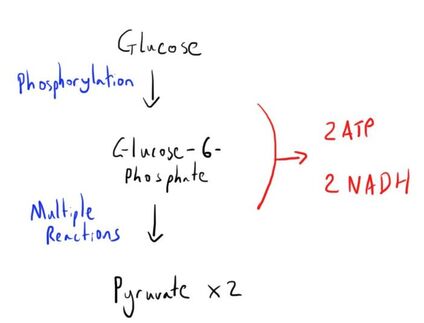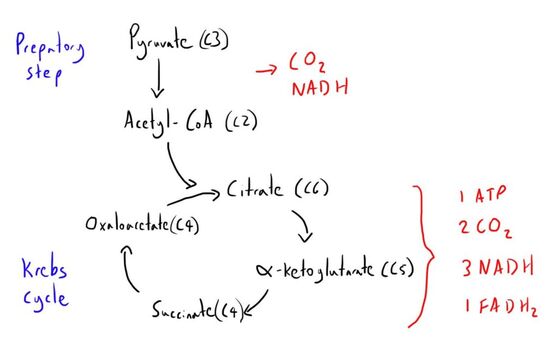Energy Production
Last updated 30th Oct 2019 - Tom Heaton
The body needs to use energy for its many chemical reactions that entail being alive.
This requires the conversion of energy into a useable form.
In animals, this form is adenosine triphosphate (ATP), known as the energy currency.
This process is undertaken in cells constantly and forms a key part of cellular metabolism.
ATP is a very unstable molecule, and so is constantly being produced.
This is a good intro video from the Crash Course team: https://www.youtube.com/watch?v=00jbG_cfGuQ
This requires the conversion of energy into a useable form.
In animals, this form is adenosine triphosphate (ATP), known as the energy currency.
This process is undertaken in cells constantly and forms a key part of cellular metabolism.
ATP is a very unstable molecule, and so is constantly being produced.
This is a good intro video from the Crash Course team: https://www.youtube.com/watch?v=00jbG_cfGuQ
The key parts are:
The most common substrate molecule for the process is glucose, and this will be primarily explored.
However, the body is able to use other molecules to create ATP through utilising different steps that feed into this pathway in different ways.
The overview of the whole process can be summarised as:
C6H12O6 + 6O2 = 6H20 + 6CO2 + Energy (ATP)
It is generally quoted that 1 molecule of glucose can produce 38 molecules of ATP.
- Glycolysis
- Krebs cycle (citric acid cycle)
- Oxidative phosphorylation - electron transport chain
The most common substrate molecule for the process is glucose, and this will be primarily explored.
However, the body is able to use other molecules to create ATP through utilising different steps that feed into this pathway in different ways.
The overview of the whole process can be summarised as:
C6H12O6 + 6O2 = 6H20 + 6CO2 + Energy (ATP)
It is generally quoted that 1 molecule of glucose can produce 38 molecules of ATP.
Glycolysis
This is the first step of the process, occurring within the cytoplasm of cells.
Glucose undergoes a series of chemical reactions to split it into 2 pyruvate molecules.
The end results of these events are:
NADH is nicotinamide adenine dinucleotide (NAD+) with an H group.
Along with flavin adenine dinucleotide (FADH) it acts as an electron carrier, in essence a temporary store of chemical energy that will be released later in the oxidative phosphorylation process.
Glucose undergoes a series of chemical reactions to split it into 2 pyruvate molecules.
The end results of these events are:
- 2 pyruvate
- 2 ATP (2 used, 4 created)
- 2 NADH
NADH is nicotinamide adenine dinucleotide (NAD+) with an H group.
Along with flavin adenine dinucleotide (FADH) it acts as an electron carrier, in essence a temporary store of chemical energy that will be released later in the oxidative phosphorylation process.
Krebs Cycle
This is the ongoing processing of the pyruvate product of glycolysis in a cycle of molecules that leads to the production of molecules which are subsequently used to create ATP.
This occurs within the mitochondria, with the pyruvate being transported in by a pyruvate transporter protein in the cell membrane.
For each pyruvate there is an initial preparatory step, converting it to acetyl-CoA by the action of pyruvate dehydrogenase.
This results in:
This step irreversibly channels the pyruvate into Krebs cycle, which is important as pyruvate may have many other routes e.g. conversion to lactate.
This occurs within the mitochondria, with the pyruvate being transported in by a pyruvate transporter protein in the cell membrane.
For each pyruvate there is an initial preparatory step, converting it to acetyl-CoA by the action of pyruvate dehydrogenase.
This results in:
- 1 acetyl-CoA
- 1 NADH
- 1 CO2
This step irreversibly channels the pyruvate into Krebs cycle, which is important as pyruvate may have many other routes e.g. conversion to lactate.
This acetyl-CoA then enters a cycle of chemical reactions.
The cycle produces a number of important products, before going back to the start (not all steps are included in the diagram above).
The resulting products of each cycle (assuming 1 acetyl-CoA entering) is:
Whilst a small amount of ATP has been produced so far, much of the potential remains with the other molecules that have been produced, mainly NADH, which are electron carriers.
This requires the final step to release.
It is worthwhile summarising what has been produced from each glucose molecule by this step in the process:
The cycle produces a number of important products, before going back to the start (not all steps are included in the diagram above).
The resulting products of each cycle (assuming 1 acetyl-CoA entering) is:
- 1 ATP
- 3 NADH
- 1 FADH2
- 2 CO2
Whilst a small amount of ATP has been produced so far, much of the potential remains with the other molecules that have been produced, mainly NADH, which are electron carriers.
This requires the final step to release.
It is worthwhile summarising what has been produced from each glucose molecule by this step in the process:
- 4 ATP (2 in glycolysis, 2 in Krebs cycle)
- 10 NADH (2 in glycolysis, 2 in the preparatory step, 6 in Krebs cycle)
- 2 FADH2
- 6 CO2
Oxidative Phosphorylation
This process is also known as the electron transport chain, and occurs across the inner membrane of the mitochondria.
Essentially, the energy from the electrons carried by the NADH and FADH2 molecules is used to transport H+ ions into the intermembrane space.
As you will appreciate from the numbers so far, this is where the vast majority of ATP is produced.
Part of this process also utilises oxygen and creates water.
The final step is that the energy electrochemical potential is used to create ATP.
The H+ ions flow back into the mitochondrial matrix through the central channel of the enzyme ATP synthase, providing the energy for the combination of ADP and inorganic phosphate into ATP.
Electrons are essentially taken off the NADH molecule and passed along the chain of 4 proteins in the electron transport chain.
In the process, H+ ions are pumped from the matrix into the intermembrane space - 10 for each NADH molecule, 6 for each FADH2.
The final protein, cytochrome oxidase, transfers the electrons to oxygen (the final electron acceptor) to reduce it into water.
This ‘uses’ ½ an O2 molecule and creates 1 H2O molecule per NADH.
The H+ ions flowing back into the mitochondrial matrix provide the energy for phosphorylation of ADH.
Each 4 H+ ions allows the creation of 1 ATP, so this is 2.5 ATP molecules per NADH.
The whole process of oxidative phosphorylation therefore creates 26-28 molecules of ATP from the products of 1 glucose molecule (excluding the ATP previously produced).
This variation is because the NADH produced in glycolysis has to be transported into the mitochondria, and one mechanism for this may reduce the amount of H+ it transports into the intermembrane space.
These videos provide a more detailed overview:
https://www.youtube.com/watch?v=jU2lnPwTXP0
Essentially, the energy from the electrons carried by the NADH and FADH2 molecules is used to transport H+ ions into the intermembrane space.
As you will appreciate from the numbers so far, this is where the vast majority of ATP is produced.
Part of this process also utilises oxygen and creates water.
The final step is that the energy electrochemical potential is used to create ATP.
The H+ ions flow back into the mitochondrial matrix through the central channel of the enzyme ATP synthase, providing the energy for the combination of ADP and inorganic phosphate into ATP.
Electrons are essentially taken off the NADH molecule and passed along the chain of 4 proteins in the electron transport chain.
In the process, H+ ions are pumped from the matrix into the intermembrane space - 10 for each NADH molecule, 6 for each FADH2.
The final protein, cytochrome oxidase, transfers the electrons to oxygen (the final electron acceptor) to reduce it into water.
This ‘uses’ ½ an O2 molecule and creates 1 H2O molecule per NADH.
The H+ ions flowing back into the mitochondrial matrix provide the energy for phosphorylation of ADH.
Each 4 H+ ions allows the creation of 1 ATP, so this is 2.5 ATP molecules per NADH.
The whole process of oxidative phosphorylation therefore creates 26-28 molecules of ATP from the products of 1 glucose molecule (excluding the ATP previously produced).
This variation is because the NADH produced in glycolysis has to be transported into the mitochondria, and one mechanism for this may reduce the amount of H+ it transports into the intermembrane space.
These videos provide a more detailed overview:
https://www.youtube.com/watch?v=jU2lnPwTXP0
Links & References
- Crash course. Youtube. https://www.youtube.com/watch?v=00jbG_cfGuQ
- Hasudungan, A. Human metabolism map I. Youtube. 2013. https://www.youtube.com/watch?v=WO-YKeJF_zc&t=62s
- Hasudungan, A. Human metabolism map II. Youtube. 2013. https://www.youtube.com/watch?v=q6TNYCCyeA8
- Hasudungan, A. Part I - Oxidative phosphorylation, electron transport chain. Youtube. 2013. https://www.youtube.com/watch?v=jU2lnPwTXP0
- Hasudungan, A. Part II - Oxidative phosphorylation, electron transport chain. Youtube. 2013. https://www.youtube.com/watch?v=uAybMbGkngU
- Duff, E. Metabolic pathways. e-LFH. 2012.
- Guyton, A. Hall, J. Textbook of medical physiology (11th ed). 2006. Elsevier Saunders.


